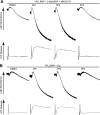Negative regulation of Gq-mediated pathways in platelets by G(12/13) pathways through Fyn kinase
- PMID: 21592972
- PMCID: PMC3129198
- DOI: 10.1074/jbc.M110.212274
Negative regulation of Gq-mediated pathways in platelets by G(12/13) pathways through Fyn kinase
Abstract
Platelets contain high levels of Src family kinases (SFKs), but their functional role downstream of G protein pathways has not been completely understood. We found that platelet shape change induced by selective G(12/13) stimulation was potentiated by SFK inhibitors, which was abolished by intracellular calcium chelation. Platelet aggregation, secretion, and intracellular Ca(2+) mobilization mediated by low concentrations of SFLLRN or YFLLRNP were potentiated by SFK inhibitors. However, 2-methylthio-ADP-induced intracellular Ca(2+) mobilization and platelet aggregation were not affected by PP2, suggesting the contribution of SFKs downstream of G(12/13), but not G(q)/G(i), as a negative regulator to platelet activation. Moreover, PP2 potentiated YFLLRNP- and AYPGKF-induced PKC activation, indicating that SFKs downstream of G(12/13) regulate platelet responses through the negative regulation of PKC activation as well as calcium response. SFK inhibitors failed to potentiate platelet responses in the presence of G(q)-selective inhibitor YM254890 or in G(q)-deficient platelets, indicating that SFKs negatively regulate platelet responses through modulation of G(q) pathways. Importantly, AYPGKF-induced platelet aggregation and PKC activation were potentiated in Fyn-deficient but not in Lyn-deficient mice compared with wild-type littermates. We conclude that SFKs, especially Fyn, activated downstream of G(12/13) negatively regulate platelet responses by inhibiting intracellular calcium mobilization and PKC activation through G(q) pathways.
Figures







Similar articles
-
The Src family kinases and protein kinase C synergize to mediate Gq-dependent platelet activation.J Biol Chem. 2012 Nov 30;287(49):41277-87. doi: 10.1074/jbc.M112.393124. Epub 2012 Oct 12. J Biol Chem. 2012. PMID: 23066026 Free PMC article.
-
Role of G protein-gated inwardly rectifying potassium channels in P2Y12 receptor-mediated platelet functional responses.Blood. 2004 Sep 1;104(5):1335-43. doi: 10.1182/blood-2004-01-0069. Epub 2004 May 13. Blood. 2004. PMID: 15142872
-
Gq pathway regulates proximal C-type lectin-like receptor-2 (CLEC-2) signaling in platelets.J Biol Chem. 2017 Sep 1;292(35):14516-14531. doi: 10.1074/jbc.M117.791012. Epub 2017 Jul 13. J Biol Chem. 2017. PMID: 28705934 Free PMC article.
-
Pyk2 downstream of G12/13 pathways regulates platelet shape change through RhoA/p160ROCK.Biochem Biophys Res Commun. 2020 Jun 4;526(3):738-743. doi: 10.1016/j.bbrc.2020.03.130. Epub 2020 Apr 4. Biochem Biophys Res Commun. 2020. PMID: 32265034
-
Diverse functions of protein kinase C isoforms in platelet activation and thrombus formation.J Thromb Haemost. 2010 Mar;8(3):454-62. doi: 10.1111/j.1538-7836.2009.03722.x. Epub 2009 Dec 11. J Thromb Haemost. 2010. PMID: 20002545 Review.
Cited by
-
The Src family kinases and protein kinase C synergize to mediate Gq-dependent platelet activation.J Biol Chem. 2012 Nov 30;287(49):41277-87. doi: 10.1074/jbc.M112.393124. Epub 2012 Oct 12. J Biol Chem. 2012. PMID: 23066026 Free PMC article.
-
Human melanopsin forms a pigment maximally sensitive to blue light (λmax ≈ 479 nm) supporting activation of G(q/11) and G(i/o) signalling cascades.Proc Biol Sci. 2013 Apr 3;280(1759):20122987. doi: 10.1098/rspb.2012.2987. Print 2013 May 22. Proc Biol Sci. 2013. PMID: 23554393 Free PMC article.
-
Maintenance of murine platelet homeostasis by the kinase Csk and phosphatase CD148.Blood. 2018 Mar 8;131(10):1122-1144. doi: 10.1182/blood-2017-02-768077. Epub 2018 Jan 4. Blood. 2018. PMID: 29301754 Free PMC article.
-
Signalling through Src family kinase isoforms is not redundant in models of thrombo-inflammatory vascular disease.J Cell Mol Med. 2018 Sep;22(9):4317-4327. doi: 10.1111/jcmm.13721. Epub 2018 Jul 4. J Cell Mol Med. 2018. PMID: 29974666 Free PMC article.
-
Calcium-Dependent Src Phosphorylation and Reactive Oxygen Species Generation Are Implicated in the Activation of Human Platelet Induced by Thromboxane A2 Analogs.Front Pharmacol. 2018 Sep 26;9:1081. doi: 10.3389/fphar.2018.01081. eCollection 2018. Front Pharmacol. 2018. PMID: 30319416 Free PMC article.
References
Publication types
MeSH terms
Substances
Grants and funding
LinkOut - more resources
Full Text Sources
Molecular Biology Databases
Miscellaneous

